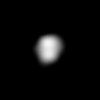 | |
| Discovery | |
|---|---|
| Discovered by | Stephen P. Synnott / Voyager 2 |
| Discovery date | January 13, 1986 |
| Mean orbit radius | 75,255.613 ± 0.057 km[1] |
| Eccentricity | 0.00007 ± 0.000073[1] |
| Orbital period | 0.623527470 ± 0.000000017 d[1] |
| Inclination | 0.03063 ± 0.028° (to Uranus' equator)[1] |
| Satellite of | Uranus |
| Physical characteristics | |
| Dimensions | 128 × 64 × 64 km[2] |
| Mean radius | 40.3 ± 8 km[2][3][4] |
| Surface area | ~25,000 km²[5] |
| Volume | ~380,000 km³[5] |
| Mass | ~3.6 × 1017 kg[5] |
| Mean density | ~1.3 g/cm³ assumed[3] |
| Equatorial surface gravity | ~0.014 m/s2[5] |
| Escape velocity | ~0.034 km/s[5] |
| Rotation period | synchronous[2] |
| Axial tilt | zero[2] |
| Albedo | 0.08 ± 0.01[6] |
| Temperature | ~64 K[5] |
| | |
Belinda (pronounced /bɨˈlɪndə/ bə-LIN-də) is an inner satellite of the planet Uranus. Belinda was discovered from the images taken by Voyager 2 on 1986-01-13 and was given the temporary designation S/1986 U 5.[7] It is named after the heroine of Alexander Pope's The Rape of the Lock. It is also designated Uranus XIV.[8]
Belinda belongs to the Portia Group of satellites, which also includes Bianca, Cressida, Desdemona, Portia, Juliet, Cupid, Rosalind and Perdita.[6] These satellites have similar orbits and photometric properties.[6] Other than its orbit,[1] radius of 45 km[2] and geometric albedo of 0.08[6] virtually nothing is known about it.
The Voyager 2 images show Belinda as an elongated object with its major axis pointing towards Uranus. The moon is very elongated, with its short axis 0.5 ± 0.1 times the long axis.[2] Its surface is grey in color.[2]
0 comments:
Post a Comment